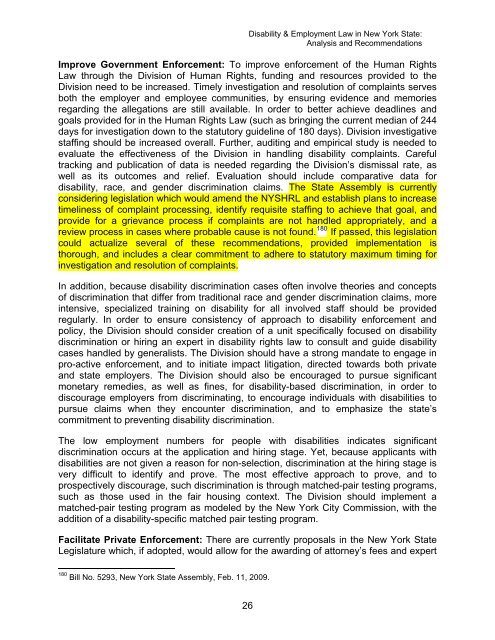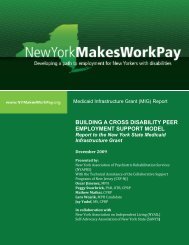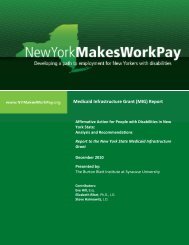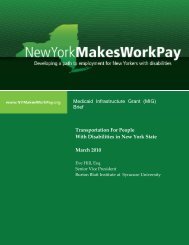Disability & Employment Law in New York State - Cornell University
Disability & Employment Law in New York State - Cornell University
Disability & Employment Law in New York State - Cornell University
You also want an ePaper? Increase the reach of your titles
YUMPU automatically turns print PDFs into web optimized ePapers that Google loves.
<strong>Disability</strong> & <strong>Employment</strong> <strong>Law</strong> <strong>in</strong> <strong>New</strong> <strong>York</strong> <strong>State</strong>:Analysis and RecommendationsImprove Government Enforcement: To improve enforcement of the Human Rights<strong>Law</strong> through the Division of Human Rights, fund<strong>in</strong>g and resources provided to theDivision need to be <strong>in</strong>creased. Timely <strong>in</strong>vestigation and resolution of compla<strong>in</strong>ts servesboth the employer and employee communities, by ensur<strong>in</strong>g evidence and memoriesregard<strong>in</strong>g the allegations are still available. In order to better achieve deadl<strong>in</strong>es andgoals provided for <strong>in</strong> the Human Rights <strong>Law</strong> (such as br<strong>in</strong>g<strong>in</strong>g the current median of 244days for <strong>in</strong>vestigation down to the statutory guidel<strong>in</strong>e of 180 days). Division <strong>in</strong>vestigativestaff<strong>in</strong>g should be <strong>in</strong>creased overall. Further, audit<strong>in</strong>g and empirical study is needed toevaluate the effectiveness of the Division <strong>in</strong> handl<strong>in</strong>g disability compla<strong>in</strong>ts. Carefultrack<strong>in</strong>g and publication of data is needed regard<strong>in</strong>g the Division’s dismissal rate, aswell as its outcomes and relief. Evaluation should <strong>in</strong>clude comparative data fordisability, race, and gender discrim<strong>in</strong>ation claims. The <strong>State</strong> Assembly is currentlyconsider<strong>in</strong>g legislation which would amend the NYSHRL and establish plans to <strong>in</strong>creasetimel<strong>in</strong>ess of compla<strong>in</strong>t process<strong>in</strong>g, identify requisite staff<strong>in</strong>g to achieve that goal, andprovide for a grievance process if compla<strong>in</strong>ts are not handled appropriately, and areview process <strong>in</strong> cases where probable cause is not found. 180 If passed, this legislationcould actualize several of these recommendations, provided implementation isthorough, and <strong>in</strong>cludes a clear commitment to adhere to statutory maximum tim<strong>in</strong>g for<strong>in</strong>vestigation and resolution of compla<strong>in</strong>ts.In addition, because disability discrim<strong>in</strong>ation cases often <strong>in</strong>volve theories and conceptsof discrim<strong>in</strong>ation that differ from traditional race and gender discrim<strong>in</strong>ation claims, more<strong>in</strong>tensive, specialized tra<strong>in</strong><strong>in</strong>g on disability for all <strong>in</strong>volved staff should be providedregularly. In order to ensure consistency of approach to disability enforcement andpolicy, the Division should consider creation of a unit specifically focused on disabilitydiscrim<strong>in</strong>ation or hir<strong>in</strong>g an expert <strong>in</strong> disability rights law to consult and guide disabilitycases handled by generalists. The Division should have a strong mandate to engage <strong>in</strong>pro-active enforcement, and to <strong>in</strong>itiate impact litigation, directed towards both privateand state employers. The Division should also be encouraged to pursue significantmonetary remedies, as well as f<strong>in</strong>es, for disability-based discrim<strong>in</strong>ation, <strong>in</strong> order todiscourage employers from discrim<strong>in</strong>at<strong>in</strong>g, to encourage <strong>in</strong>dividuals with disabilities topursue claims when they encounter discrim<strong>in</strong>ation, and to emphasize the state’scommitment to prevent<strong>in</strong>g disability discrim<strong>in</strong>ation.The low employment numbers for people with disabilities <strong>in</strong>dicates significantdiscrim<strong>in</strong>ation occurs at the application and hir<strong>in</strong>g stage. Yet, because applicants withdisabilities are not given a reason for non-selection, discrim<strong>in</strong>ation at the hir<strong>in</strong>g stage isvery difficult to identify and prove. The most effective approach to prove, and toprospectively discourage, such discrim<strong>in</strong>ation is through matched-pair test<strong>in</strong>g programs,such as those used <strong>in</strong> the fair hous<strong>in</strong>g context. The Division should implement amatched-pair test<strong>in</strong>g program as modeled by the <strong>New</strong> <strong>York</strong> City Commission, with theaddition of a disability-specific matched pair test<strong>in</strong>g program.Facilitate Private Enforcement: There are currently proposals <strong>in</strong> the <strong>New</strong> <strong>York</strong> <strong>State</strong>Legislature which, if adopted, would allow for the award<strong>in</strong>g of attorney’s fees and expert180 Bill No. 5293, <strong>New</strong> <strong>York</strong> <strong>State</strong> Assembly, Feb. 11, 2009.26





